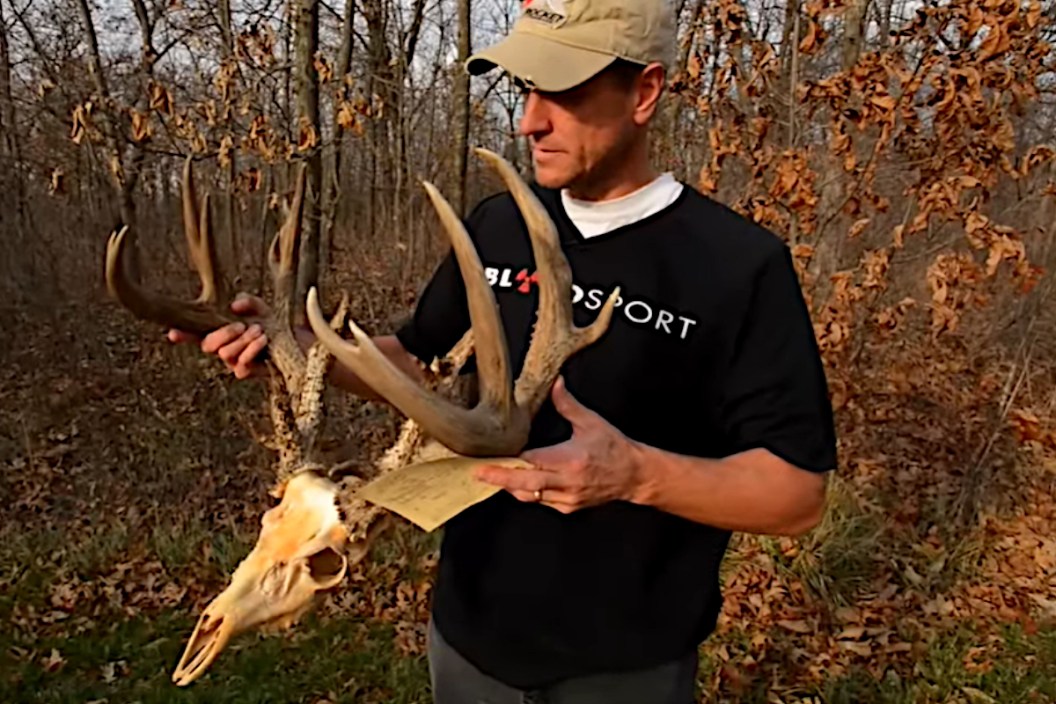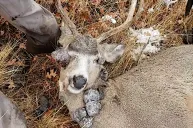The bluetongue virus can devastate a deer population in short order.
Have you ever had a buck on trail camera all summer that suddenly disappeared never to be seen again come late summer and early fall? Or maybe you found a ton of dead deer near water sources in your hunting area. There is a chance your hunting area may have been hit with an outbreak of epizootic hemorrhagic disease, also known as bluetongue disease.
This wildlife disease is caused and spread by biting midges and gnats. Mortality rates for infected animals are extremely high. Across North America, many a hunter has had their season completely ruined because of a bad EHD outbreak.
Today we will give you all the facts you need to know about this viral disease. We will also tell you how to identify the clinical signs of EHD, and what you should do if you suspect an outbreak in your hunting area.
What is bluetongue disease?
Technically, there are two types of orbivirus disease that usually get called "EHD virus" interchangeably because there is almost no difference in the symptoms or effects on the animals. The first is epizootic hemorrhagic disease (EHD) and the second is bluetongue virus (BTV). Both diseases transmit in the exact same fashion, through biting midges and gnats, also known as "culicoides." You may hear some hunters refer to these insects as "no-see-ums" because they are so tiny.
Either way, the reason most Epizootic hemorrhagic disease virus outbreaks occur in late summer or early fall when these biting flies are peaking in numbers. Coincidentally, this is usually the time of year when drought conditions are at their peak for many areas. When the deer herds are thirsty during these times, they congregate on creeks and shallow pools where the gnats and midges carrying the virus are breeding. This creates a perfect storm for an outbreak when these insects feed on a deer, transmitting the virus.
While the EHD virus can affect domestic animals, it sometimes affects mule deer and pronghorn antelope too. Arizona wildlife officials have recorded some outbreaks in bighorn sheep. For the most part, whitetail deer outbreaks seem to be most common. These types of outbreaks are usually a risk until the first hard frost, which kills the midges spreading the disease.
According to the Michigan Department of Natural Resources, EHD has likely been around for a very long time. The first known outbreak occurred in 1955. However, there are reports of deer die-offs that sound remarkably like EHD dating back to the 1890s.
What are the symptoms of bluetongue disease?
Animal health usually deteriorates within seven days of being bitten by an infected insect. Sick deer usually show obvious signs something is wrong. The most glaring is they will lose fear of humans, and may show a loss of appetite. EHD also causes a deer's temperature to shoot up, and excessive salivation. As a result, many infected deer are later found dead in or around water as they try to seek relief from the high fever and thirst.
Deer may also have difficulty breathing and appear in respiratory distress. The disease causes internal hemorrhages and a lack of oxygen in the blood. This often leads to ulcers, and swelling of the tongue, which changes color to take on a blue appearance, hence the name. In the final stages, many animals exhibit lameness as their health fails before passing. Simply put, it is an ugly, and painful way for any animal to die.
Is blue tongue fatal to deer?
While something like chronic wasting disease is always fatal, some deer can and do survive EHD. Unfortunately, the number of deer that do live is extremely low. According to Purdue University, nearly 90 percent of deer that contract EHD will die from it. Those that do will build up antibodies against the disease in case they are exposed again. One good thing is that does that survive an outbreak often pass those antibodies down to their offspring the following year, helping to shield a new generation of deer.
Any deer that do survive the disease usually do not come away without scars though. The obvious sign is usually sloughing or cracked hooves. If you notice split hooves on two or more feet, the deer may have survived EHD at some point. Another symptom to check for is lesions in the mouth. According to the Kentucky Department of Fish and Wildlife Resources, EHD survivors may also show signs of lesions in their rumen or stomach lining. Watch carefully for these signs when you are field dressing your harvests this fall.
Is a deer with bluetongue disease safe to eat?
While most wildlife agencies and biologists recommend not eating a deer infected with CWD, blue tongue disease only affects domestic and wild ruminants (hooved animals). EHD is also not contagious, it is only spread through biting flies. This means that deer, even survivors should be safe for human consumption. We say should because most state wildlife agencies will also recommend you not eat an obviously sick deer of any kind, just to be on the safe side. The choice of whether to eat an infected deer or not is up to you.
How common is bluetongue disease? And can it be prevented?
Unfortunately, there is no known way to prevent the spread of bluetongue disease. While it is a common deer disease, the way it strikes and takes victims can be wildly random. Some hunters encounter nightmare scenarios where nearly all the bucks on their land turn up dead only weeks before the first archery seasons start. In some areas, it may only kill a handful of deer in a whole county. The severity of an outbreak likely has much to do with how heavy the midge and gnat hatches are each season. Instances of drought seem to amplify cases of the disease.
Fortunately, most places do not deal with a major outbreak every season. Some areas may go a decade or more between EHD outbreaks. If your area is experiencing an outbreak, do not panic. Remember that deer herds are quite resilient, and even in bad years, most bounce back from an EHD outbreak the following season.
Although you should be aware that it may lead to lousy hunting for a season or two. This is just something we as hunters must live with. In 2020, North Dakota ended up giving hunters refunds on their licenses because an EHD outbreak was so severe. Fortunately, this was a rare scenario.
What should I do if I suspect an EHD outbreak in my area?
If you are getting your treestands set for the season and start to find tons of deer dead around creeks and waterholes, your best bet is to contact your local state wildlife agency to report the matter. They may or may not send investigators out to see if it is really an EHD outbreak or something else. Biologists usually diagnose the disease post-mortem through the testing of tissue, lung, or lymph node samples.
Even though there is no known way to combat EHD yet, it is worth doing your part and reporting a possible outbreak. Because it gives scientists more data and knowledge they can use to better understand EHD. With a little luck, one day there will be a way to eradicate this deadly deer disease completely.
Products featured on Wide Open Spaces are independently selected by our editors. However, when you buy something through our links, we may earn a commission.
For more outdoor content from Travis Smola, be sure to follow him on Twitter and check out his Geocaching and Outdoors with Travis YouTube channels.
NEXT: THE AXIS DEER AND HOW THEY'RE IMPACTING PARTS OF THE UNITED STATES
WATCH





